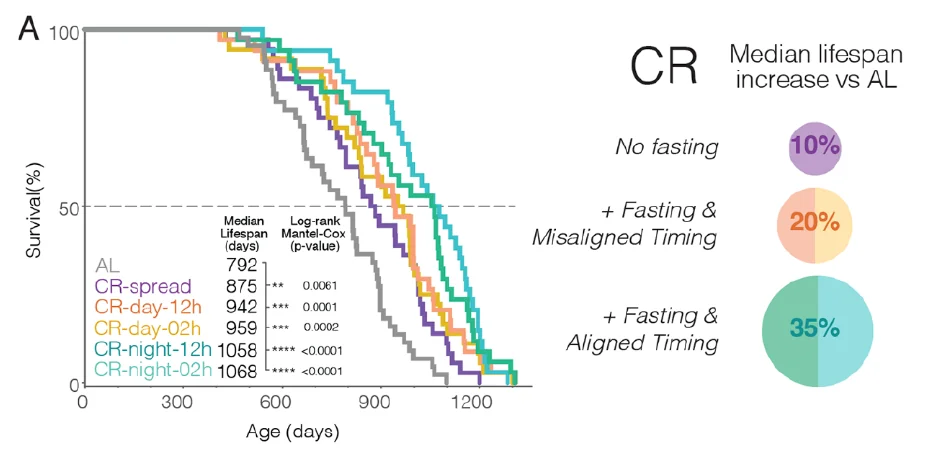Yes, the OP’s question is a very valid one.
FWIW, Matt, Kaeberlein, in one of his yt videos stated that rapa in comparison to CR has a small subset of health/life extension benefits, implying that CR has all the benefits of rapa along that axis, plus a vastly larger pool of additional benefits not present with rapa. In other words, in a Venn diagram, rapa would be a small circle completely inside a much larger CR circle.
I’m not sure if that statement is valid in all respects, but is probably roughly correct.
But is it true that all the benefits of rapa are down to crypto-CR? If that were true, then rapa would be nothing more than an appetite suppressant. Equivalent to a roll of duct tape, where in the middle of each of your meals you tape your mouth shut, thus dramatically lowering your caloric intake. I have read the long threads about buying rapa from Indian pharmacies, and the various price comparisons, but I have also priced duct tape at Home Depot and a year’s supply of tape, divided by the number of meals in a year still comes out much cheaper. There are pluses and minuses with both. Tape doesn’t need a doctor’s prescription, is readily available, no issues with customs and imports, side effects are similar wrt. skin rashes, though with tape it’s only around the mouth area; possibly similar psychological/mood stressors etc.
If rapa somehow causes calories to bypass absorption, then it’s essentially similar to various agents that hobble digestion and/or burn calories in the process (simple example: two drinks with the same caloric content - if one of them is icy cold, your body will need to warm it up and you will as a result absorb net fewer calories).
If rapa causes digestion inefficiency, then the same amount of food will yield fewer net calories, because it raises the cost of processing (requiring the production of more enzymes etc.).
Rapa may also somehow render calories less deleterious. There were a series of studies by Holloszy et al. of “rats with cold feet” (google it). In those studies, the rats were kept standing in cold water, as a result, they ate more calories than CR’d rats, yet had the same life extension - a unique situation, as no other intervention which achieves a relative calorie deficit by “calories out”, results in an increase in max lifespan (for example exercise also burns off extra calories, but does not result in an increase of max LS, although it does extend median LS and healthspan, i.e., it essentially squares the survival curve). Only CR and cold therapy results in true max LE… and now possibly rapa? But if rapa is just crypto-CR, then it’s back to those two.
However, this is something that we should be able to determine at least in one respect. CR is dose dependent (up to a point, when the organism starves to death). If rapa works by cutting the intake of calories, then increasing the dose should result in the mice eating less and less. Was that true in the ITP trials, or any other rapa trials? Did the mice eat progressively less as the dose of rapa was increased?
But even if we settle that aspect, there are the other ways as I outlined above, where rapa can still work through caloric manipulation. CR is very straightforward in the respect of calories: it’s down to consumption. But there are other mechanisms of restricting calories, such as absorption, and the other mechanisms I mentioned.
So the question posed: is rapa just CR can be answered (dose dependent restriction of calorie intake). But that still doesn’t answer the deeper question of whether rapa effects are mediated through calories at all?
After all, if you make a hole in your throat, and insert a pipe to divert all your food - or a portion of it - onto your shirt, we can say you consume ad lib unrestricted food, no CR, it just is not absorbed, so the effect is the same as if you were on CR. If rapa is that pipe (physiologically inside your body), then sure, you consume ad lib, so not CR, ostensibly, but you are still manipulating calories… if you eat twice as much as the CR person, you are not CR’d. But you absorb only half, so in effect your body takes in a CR quantity of food. Body - not mouth, a crucial distinction.
To finish this off, as the post is getting intolerably long, we know that the issue of calories, its intake and utilization, is very complex: think about bariatric surgery. On the surface, it may seem that the surgery works by simply restricting how much you can eat (in effect: CR). But we know for a fact, that that is not true, or at least only a small part of the effect. Because very shortly after the surgery, long before you lose any weight, your blood sugar and diabetic biomarkers revert to normal - far faster than happens if the same patient were to simply restrict calories to exactly the same amount but without the surgery… so we know it cannot be just about the calorie restriction. What is speculated (we still don’t have the full answer), is that the surgery causes a whole cascade of hormonal and physiological signaling that is responsible for the biggest effects on health. For example, stomach size - cut it down, and already there are effects completely apart from calories. Shortening or bypassing the small intestine, jejunum has profound effects, completely apart from calories. And so on. By changing you body, you changed how you respond to calories, not just the amount of calories you are taking in.
This complexity of calorie handling is what has to be addressed when asking if the mechanism of rapa action is through CR.
The question is good. But the answer might be quite complicated. YMMV.
